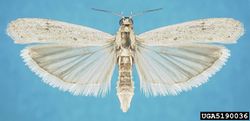Homoeosoma electellum
| Literature database |
|---|
| 24 articles sorted by: |
| • year (recent ones first) |
| • research topics |
| • countries/regions |
| • host plants |
| • list of natural enemies |

Author(s): Natasha Wright, Florida Department of Agriculture and Consumer Services
Source: IPM Images
Homoeosoma electellum (Hulst, 1887) - (sunflower moth)
This small moth is a serious, native pest of sunflowers in western and central North America. It is mainly found in the southern parts of the U.S.A. and cannot overwinter in cooler regions. However, it can migrate north, assisted by wind and occasionally reaches Canada. The larvae feed on pollen, florets and developing seeds, significantly reducing yield and seed-oil content. Each larva destroys several seeds during its development. Severe infestations can cause losses of 30-60%. It also attacks other crops.
The development from egg, through 4-5 larval stages, to mature adult lasts around 6 weeks. The mature larvae can enter diapause and overwinter in this stage. Pupation takes place in the soil. The adult is about 1 cm long, with a wingspan of around 2 cm. The forewing is light grey with some darker spots. The hindwing has a fringe of long whitish hair.
| Vernacular names | |
|---|---|
| • Deutsch: | Sonnenblumenmotte |
| • English: | sunflower moth |
| • Español: | piral del girasol |
| • Français: | pyrale du tournesol |
| • Português: | piralide del girasole |
Some authors use the name Homoeosoma electella for this species. The common names apply also to the European species, Homoeosoma nebulella.
For a review see Royer & Knodel (2019).
- Other images of Homoeosoma electellum (IPM Images and PaDIL - click to enlarge)


